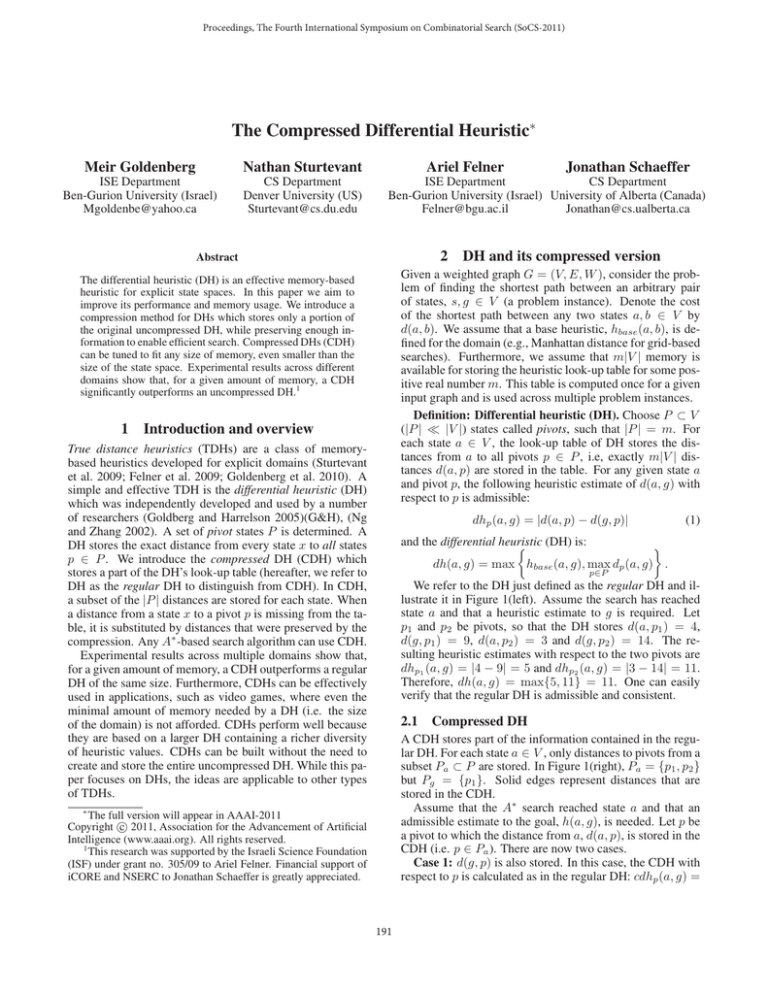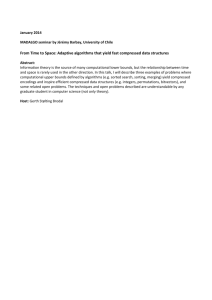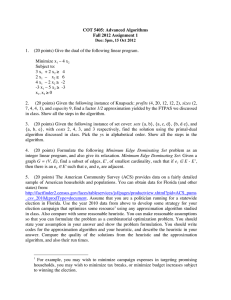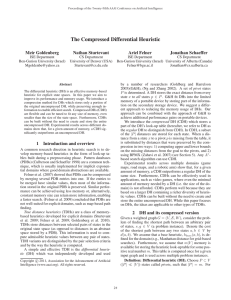
Proceedings, The Fourth International Symposium on Combinatorial Search (SoCS-2011)
The Compressed Differential Heuristic∗
Meir Goldenberg
Nathan Sturtevant
ISE Department
Ben-Gurion University (Israel)
Mgoldenbe@yahoo.ca
CS Department
Denver University (US)
Sturtevant@cs.du.edu
Ariel Felner
2
Abstract
DH and its compressed version
Given a weighted graph G = (V, E, W ), consider the problem of finding the shortest path between an arbitrary pair
of states, s, g ∈ V (a problem instance). Denote the cost
of the shortest path between any two states a, b ∈ V by
d(a, b). We assume that a base heuristic, hbase (a, b), is defined for the domain (e.g., Manhattan distance for grid-based
searches). Furthermore, we assume that m|V | memory is
available for storing the heuristic look-up table for some positive real number m. This table is computed once for a given
input graph and is used across multiple problem instances.
Definition: Differential heuristic (DH). Choose P ⊂ V
(|P | |V |) states called pivots, such that |P | = m. For
each state a ∈ V , the look-up table of DH stores the distances from a to all pivots p ∈ P , i.e, exactly m|V | distances d(a, p) are stored in the table. For any given state a
and pivot p, the following heuristic estimate of d(a, g) with
respect to p is admissible:
The differential heuristic (DH) is an effective memory-based
heuristic for explicit state spaces. In this paper we aim to
improve its performance and memory usage. We introduce a
compression method for DHs which stores only a portion of
the original uncompressed DH, while preserving enough information to enable efficient search. Compressed DHs (CDH)
can be tuned to fit any size of memory, even smaller than the
size of the state space. Experimental results across different
domains show that, for a given amount of memory, a CDH
significantly outperforms an uncompressed DH.1
1
Jonathan Schaeffer
ISE Department
CS Department
Ben-Gurion University (Israel) University of Alberta (Canada)
Felner@bgu.ac.il
Jonathan@cs.ualberta.ca
Introduction and overview
True distance heuristics (TDHs) are a class of memorybased heuristics developed for explicit domains (Sturtevant
et al. 2009; Felner et al. 2009; Goldenberg et al. 2010). A
simple and effective TDH is the differential heuristic (DH)
which was independently developed and used by a number
of researchers (Goldberg and Harrelson 2005)(G&H), (Ng
and Zhang 2002). A set of pivot states P is determined. A
DH stores the exact distance from every state x to all states
p ∈ P . We introduce the compressed DH (CDH) which
stores a part of the DH’s look-up table (hereafter, we refer to
DH as the regular DH to distinguish from CDH). In CDH,
a subset of the |P | distances are stored for each state. When
a distance from a state x to a pivot p is missing from the table, it is substituted by distances that were preserved by the
compression. Any A∗ -based search algorithm can use CDH.
Experimental results across multiple domains show that,
for a given amount of memory, a CDH outperforms a regular
DH of the same size. Furthermore, CDHs can be effectively
used in applications, such as video games, where even the
minimal amount of memory needed by a DH (i.e. the size
of the domain) is not afforded. CDHs perform well because
they are based on a larger DH containing a richer diversity
of heuristic values. CDHs can be built without the need to
create and store the entire uncompressed DH. While this paper focuses on DHs, the ideas are applicable to other types
of TDHs.
dhp (a, g) = |d(a, p) − d(g, p)|
and the differential heuristic
(DH) is:
(1)
dh(a, g) = max hbase (a, g), max dp (a, g) .
p∈P
We refer to the DH just defined as the regular DH and illustrate it in Figure 1(left). Assume the search has reached
state a and that a heuristic estimate to g is required. Let
p1 and p2 be pivots, so that the DH stores d(a, p1 ) = 4,
d(g, p1 ) = 9, d(a, p2 ) = 3 and d(g, p2 ) = 14. The resulting heuristic estimates with respect to the two pivots are
dhp1 (a, g) = |4 − 9| = 5 and dhp2 (a, g) = |3 − 14| = 11.
Therefore, dh(a, g) = max{5, 11} = 11. One can easily
verify that the regular DH is admissible and consistent.
2.1
Compressed DH
A CDH stores part of the information contained in the regular DH. For each state a ∈ V , only distances to pivots from a
subset Pa ⊂ P are stored. In Figure 1(right), Pa = {p1 , p2 }
but Pg = {p1 }. Solid edges represent distances that are
stored in the CDH.
Assume that the A∗ search reached state a and that an
admissible estimate to the goal, h(a, g), is needed. Let p be
a pivot to which the distance from a, d(a, p), is stored in the
CDH (i.e. p ∈ Pa ). There are now two cases.
Case 1: d(g, p) is also stored. In this case, the CDH with
respect to p is calculated as in the regular DH: cdhp (a, g) =
∗
The full version will appear in AAAI-2011
c 2011, Association for the Advancement of Artificial
Copyright Intelligence (www.aaai.org). All rights reserved.
1
This research was supported by the Israeli Science Foundation
(ISF) under grant no. 305/09 to Ariel Felner. Financial support of
iCORE and NSERC to Jonathan Schaeffer is greatly appreciated.
191
p1
p1
9
4
p2
3
g
a
14
9
4
p2
3
g
a
13
x 1
2
15
y
Figure 1: Regular DH (left) and compressed DH (right).
Figure 2: The environments.
dhp (a, g). The pivot p1 in Figure 1(right) demonstrates this
case, since distance to p1 is stored both from a and from g.
Therefore, cdhp1 (a, g) = dhp1 (a, g) = |4 − 9| = 5.
Case 2: p ∈
/ Pg (p2 in our example). In this case,
cdhp (a, g) is defined as follows. Equation 1 is based on
the inequalities d(a, g) ≥ d(a, p) − d(g, p) and d(a, g) ≥
d(g, p) − d(a, p). Therefore, equation 1 can be re-written as
dhp (a, g) = max {d(a, p) − d(g, p), d(g, p) − d(a, p)} . (2)
Time relative to the base heuristic
Let d(g, p) and d(g, p) denote an upper and lower bound
on the missing distance d(g, p). Using them with equation 2
gives the following admissible
heuristic with respect to p:
cdhp (a, g) = max d(a, p) − d(g, p), d(g, p) − d(a, p) .
Maximizing over all pivots yields the compressed differential heuristic (CDH): cdh(a, g) = max hbase (a, g), max cdhp (a, g) .
p∈Pa
2.2
Computing the bounds
For a given problem instance, the goal state remains unchanged for the duration of the search. Therefore, for each
pivot p, the bounds d(g, p) and d(g, p) can be precomputed
before the main search begins. These bounds are stored in
a table called the bounds table, to be used throughout the
search for this particular problem instance.
Let p ∈ P be a pivot to which the distance from the goal
state g, d(g, p), is not stored as in Case 2) above. Let x be
an arbitrary state such that the distance from x to p is stored.
More formally, p ∈
/ Pg and p ∈ Px . The triangle inequality for the vertices {g, x, p} gives the following bounds on
d(g, p) with respect to x:
dx (g, p) = d(g, x) + d(x, p), and
1.3
C
1.2
1.1
1 D D D D
C
0.9
0.8
C
0.7
0.6
0.5
0.4
0.3
0.2
0.1
0
4 2 6 /8
1/6 1/3 1/1 1
(a) ost100d
Air distance
D D DH
C C CDH
D D
C
D
C
D
C
1/4 1/2 1
C D
C D
C D
C
2
4
8 16
Memory, multiples of |V|
Memory, multiples of |V|
(b) SF Bay Area map
Figure 3: Pathfinding experiments.
All times that we report are measured in milliseconds.
Charts (a) and (b) show the time performance of both the
regular and the compressed DH for the ost100d DAO map
and the SF Bay Area road map, respectively. For the memory amounts between 1|V | and 8|V |, CDH significantly outperforms the regular DH. When larger amounts of memory
are available, regular DHs achieve good coverage of the state
space, leaving little space for improvement.
dx (g, p) = |d(g, x) − d(x, p)|
(3)
The Bounding procedure calculates the bounds by applying equation 3 to states that are in close proximity to g as
follows. Initially, for each pivot p ∈
/ Pg , we set d(g, p) = ∞
and d(g, p) = hbase (g, p). Perform a Dijkstra search from
g. For each expanded state x and for each p ∈ Px , we
use the distance d(x, p) to compute the bounds dx (g, p) and
dx (g, p). These bounds are then used to improve the global
upper and lower bounds on d(g, p). This process is continued until at least r distances d(x, p) have been seen for each
pivot p ∈
/ Pg , where r is a parameter.
3
1.3
Octile distance
D D DH
1.2
C C CDH
1.1
C D D D D D
1 D
0.9
C
0.8
0.7
C
0.6
D
C
0.5
0.4
D
C
D
0.3
C
C
0.2
C C D
C D
0.1
C
0
1
2
2
2
8 16
8
4
4
4
6
/
/
/
1/6 1/3 1/1 1 1 1
Time relative to the base heuristic
(DAO)(http://movingai.com/benchmarks). (2) Road maps
of North American cities and states.(3) Robotic Arm: A
segmented arm moves in two-dimensional space and can
have any number of segments. Here, in Figure 3, we only
provide results for the road and the game maps. However,
we also confirmed the trends on the Robotic Arm domain
and on two synthetically generated environments: rooms
maps and Delaunay graphs.
References
Felner, A.; Berrer, M.; Sturtevant, N.; and Schaeffer, J. 2009.
Abstraction-based heuristics with true distance computations. In
Proceedings of SARA.
Goldberg, A., and Harrelson, C. 2005. Computing the shortest
path: A* search meets graph theory. In SODA, 156–165.
Goldenberg, M.; Felner, A.; Sturtevant, N.; and Schaeffer, J. 2010.
Portal-based true-distance heuristics for path finding. In Proceedings of SoCS.
Ng, T., and Zhang, H. 2002. Predicting internet network distance
with coordinates-based approaches. In INFOCOM, 170–179.
Sturtevant, N.; Felner, A.; Barer, M.; Schaeffer, J.; and Burch, N.
2009. Memory-based heuristics for explicit state spaces. IJCAI
609–614.
Experimental results
We performed experiments on the 3 real-world
domains (shown in Figure 2):
(1) Dragon Age
maps taken from Bioware’s Dragon Age: Origins
192








